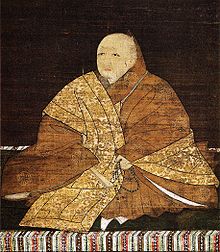Ashikaga Yoshimitsu
| Ashikaga Yoshimitsu 足利 義満 |
|
|---|---|
 |
|
| 3rd Ashikaga shogun | |
|
In office 1368–1394 |
|
| Preceded by |
Shogun: Ashikaga Yoshiakira |
| Succeeded by |
Shogun: Ashikaga Yoshimochi |
| Personal details | |
| Born | September 25, 1358 |
| Died | May 31, 1408 (aged 49) |
| Spouse(s) |
Wife: Hino Nariko Concubine: Hino Yasuko others |
| Relations |
Father: Ashikaga Yoshiakira Mother: Ki no Yoshiko |
| Children | |
Ashikaga Yoshimitsu (足利 義満?, September 25, 1358 – May 31, 1408) was the 3rd shogun of the Ashikaga shogunate, which was in power from 1368 to 1394 during the Muromachi period of Japan. Yoshimitsu was appointed shogun, hereditary head of the military estate, in 1368 at the age of ten; at twenty he was admitted to the imperial court as Acting Grand Counselor (Gon Dainagon 権大納言). In 1379, Yoshimitsu reorganized the institutional framework of the Gozan Zen 五山禅 establishment before, two years later, becoming the first person of warrior pedigree to host a reigning emperor at his private residence. In 1392, he negotiated the end of the Nanbokuchō imperial schism that had plagued politics for over half a century. Two years later he became Grand Chancellor of State (Dajō daijin 太政大臣), the highest-ranking member of the imperial court. Retiring from that and all public offices 1395, Yoshimitsu took the tonsure and moved into his Kitayama-dono (北山殿) retirement villa which, among other things, boasted a pavilion covered in gold leaf (Kinkaku shariden 金閣舎利殿). There, he received envoys from the Ming and Chosŏn courts on at least six occasions and forged the terms of a Sino-Japanese trade agreement that endured for over a century. In recognition for his diplomatic efforts (and overt displays of subservience), the Chinese sovereign pronounced Yoshimitsu "King of Japan" (Nihon kokuō 日本国王). In 1407, he set into motion a plan to become "Dajō tenno" (太上天皇), a title customarily applied to a retired emperor. Although unrealized due to his sudden death the following year, this last venture was particularly audacious because Yoshimitsu never actually sat on the Japanese throne.
Significant events shape the period during which Yoshimitsu was shogun:
Yoshimitsu constructed his residence in the Muromachi section in the capital of Kyoto in 1378. As a result, in Japanese, the Ashikaga shogunate and the corresponding time period are often referred to as the Muromachi shogunate and Muromachi period.
...
Wikipedia
